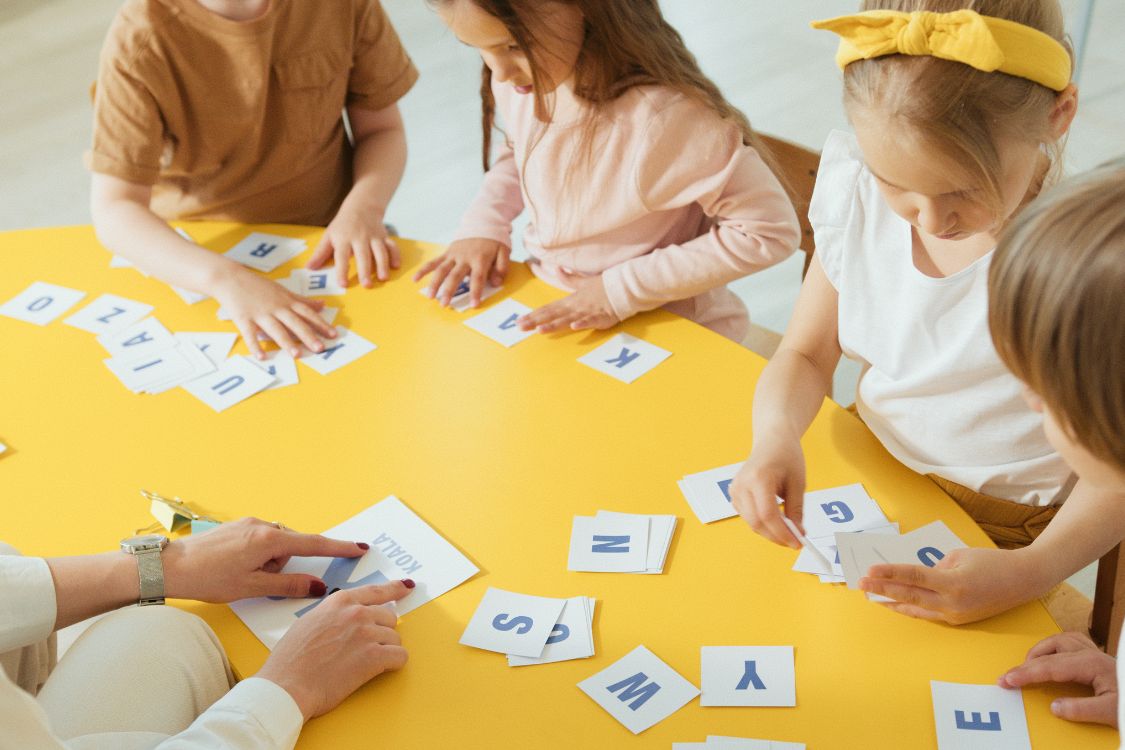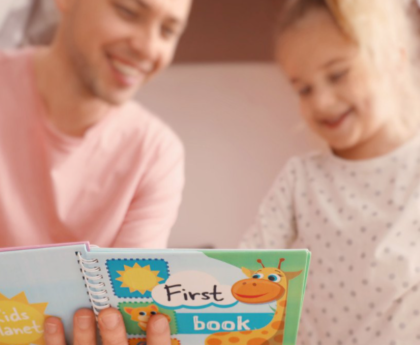If you’re reading this, you’ve likely mastered the five foundational skills of reading.
Reading mastery involves a set of important skills that build upon each other. Early readers, including your child, must be taught these essential skills to develop reading proficiency.
In this article, we’ll explore the five skills of reading and how to improve them with your child at home. Let’s dive in!
The “5 Reading Skills” Pyramid
The easiest way to understand the five foundational reading skills is to look at the reading pyramid.
The reading pyramid represents the bottom-up developmental process that children experience when becoming literate. It includes phonemic awareness, phonics, fluency, vocabulary, and comprehension.
To learn what each of these skills mean in-depth and how they work, check out our article on the Science of Reading. Now, let’s look at some ways children can practice reading skills at each level.
1. Developing Phonemic Awareness
Phonemic awareness sets the early foundation of literacy. During the first few years of life, children pick up verbal language naturally from people around them. In every language, words are made up of smaller sounds put together. These individual sounds are called phonemes.
Children develop phonemic awareness as they realize words are composed of different sounds. For example, the word dog is made up of three phonemes: /d/ /o/ /g/. The word smooth is made of four phonemes: /s/ /m/ /oo/ /th/.
Three important phonemic awareness skills are:
- Blending sounds to read words (ex. /b/ /a/ /t/ is “bat”)
- Segmenting words into individual phonemes (ex. bat has three sounds /b/ /a/ /t/)
- Manipulating sounds in words (ex. change the first sound in “bat” to /p/ – “pat”)
There are several ways you can practice phonemic awareness with your child:
- Read rhyming books, emphasizing the rhymes
- Emphasize word syllables by playfully clapping along with each syllable (example: “mic-ro-phone”)
- Sing songs and nursery rhymes with your child, emphasizing the rhymes
- Guide your child through blending letter sounds together to make words
- Play “I Spy” games using the beginning sounds of words as clues
- Use Reading.com’s letter Sound Stories, Saying Words & Saying Sounds activities
As your child obtains basic reading skills like phonemic awareness, they’ll grow familiar with blending different sounds to make words. This process also helps them with the next reading skill: phonics.
2. Mastering Phonics
Phonics skills give children the ability to correlate phonemes (sounds) with graphemes (written letters). This is called Grapheme-Phoneme Correspondence (GPC).
Most people are born with the two parts of the brain that facilitate reading: the orthographic processor (visual) and phonological processor (verbal). However, to connect both the visual and verbal processes that enable reading, phonics skills should be explicitly taught.
Phonics skills are important to literacy. Children learn the alphabet and then learn the sounds that individual letters and groups of letters make. With this knowledge, they begin to decode words.
Reading tips to improve phonics skills include:
- Practice naming letters in your environment, in games, and in books
- Talk about sounds that letters represent (example: M says /mmmmm/)
- Listen to your child as they read aloud and correct their decoding mistakes when they get stuck
- Read out loud to your child as they follow along
- Point out letters and words you see throughout daily activities. Ask your child what sound it makes or if they can read the word
- Avoid teaching strategies that ask your child to look away from the word (ex. do not look ask your child to look at a picture to help them guess a word
- Practice blending skills with your child using Reading.com’s Blending Letter Sounds & Word Reading sections
The better your child gets at phonics, the more words they’ll be able to learn. The more words they learn, the more they build their fluency.
3. Improving Fluency
Reading fluency is the ability to read words quickly, correctly, and with accurate expression. Fluency is essential for reading comprehension– in other words, understanding the meaning of words and their context within text.
For early readers, fluency doesn’t come easily. It takes effort. But with a stronger understanding of phonemes, phonics, and decoding, fluency gradually improves.
Here are a few practices you can do with your child to strengthen reading fluency:
- Read to your child out loud, modeling proper reading fluency
- Let him or her choose books that contain words they can decode (decodable books)
- Practice daily reading activities together
- Have your child choose a reading partner (family members, friends, or classmates)
- Include your child in conversations with interesting or new vocabulary words
- Reread unlocked books in Reading.com to reinforce the 5 skills while improving speed and accuracy
Keep in mind that fluency and vocabulary are closely related. More importantly, the two skills are required for achieving reading comprehension.
4. Expanding Vocabulary
Vocabulary, or the collection of words that an individual knows, will expand as literacy skills improve. Fluency encourages vocabulary development as children learn new word meanings in the context of what they’re reading, hearing, and learning. Vocabulary-building also supports fluency by making it easier for children to recognize and understand words they might be decoding for the first time.
As an unconstrained skill, learning new vocabulary words is a lifelong process. That said, children can’t achieve reading comprehension if they don’t understand what words mean in a text. Even if a child can sound out words and correctly apply their phonics knowledge, a lack of vocabulary skills will hinder their reading proficiency.
There are several strategies to expand your child’s vocabulary:
- Play vocabulary matching games together
- Introduce new vocabulary words in context during regular dialogue
- Encourage your child to vocalize their curiosity and inquiry about what words mean
- Avoid “dumbing down” your language with your child. Include them in age-appropriate family conversations
- Keep a steady pace– don’t overwhelm your child with too many new words at once
- Let your child read decodable books to learn new words with Reading.com
When children grasp fundamental reading skills and begin to expand their vocabulary, they’re on their way to experiencing the greatest joy of reading: comprehension.
5. Achieving Comprehension
Comprehension is the ultimate goal of reading. According to Scarborough’s Reading Rope, reading comprehension = word reading x language comprehension.
Reading comprehension is composed of five factors:
- background knowledge (ex. facts, concepts, experience)
- verbal reasoning (ex. metaphor, inference)
- language structures (ex. syntax, semantics)
- vocabulary (ex. knowledge of words)
- literary knowledge (ex. genre)
Reading comprehension abilities can directly impact a student’s education and quality of life. In the U.S., low literacy scores in adults have been shown to influence real-world outcomes. Below-average literacy can lead to educational difficulty, financial strain, limited access to healthcare, feelings of social isolation, and even increased risks of mental illness.
The best way to prevent substandard literacy is to address reading challenges early on. Understanding the words we read sparks critical thinking, captivates us into meaningful stories, enables us to navigate life in society, and empowers us to learn a variety of subjects.
If a child struggles with any of the five reading skills at their developmental level, they’re positioned to struggle with comprehension. When reading comprehension remains difficult, it can lead to a distaste for reading and learning.
How can parents help children achieve reading comprehension? Here are some ideas:
- Talk with an educator or doctor about your child’s reading struggles
- Get a reading assessment for your child to identify areas of improvement
- Revisit instruction for the reading skills your child needs to learn before moving on to more advanced reading
- Break up reading passages into smaller sections with your child. Review each section before moving on
- Ask your child questions about what they’ve read
- Maintain regular vocabulary and fluency practices
- Engage in Reading.com’s comprehension questions after reading
Children achieve different levels of comprehension as their literacy skills continue to develop. Ideally, proper reading instruction equips students to become fully literate individuals who can learn and make informed decisions for the rest of their lives.
Gain Foundational Reading Skills With the Reading.com App
Whether it be phonemic awareness, phonics, fluency, vocabulary, or comprehension, the literacy skills your child struggles with most can be improved. With evidence-based instruction methods, encouragement, and practice, anyone can develop a lifelong love of reading.
One engaging, fun way your child can practice their reading skills is through the Reading.com app. Its reading activities and games deliver a personalized learning structure so that your child can strengthen their literacy weak points and continue to build their strengths.
To help your child gain all the skills of reading, download the Reading.com app for free!





